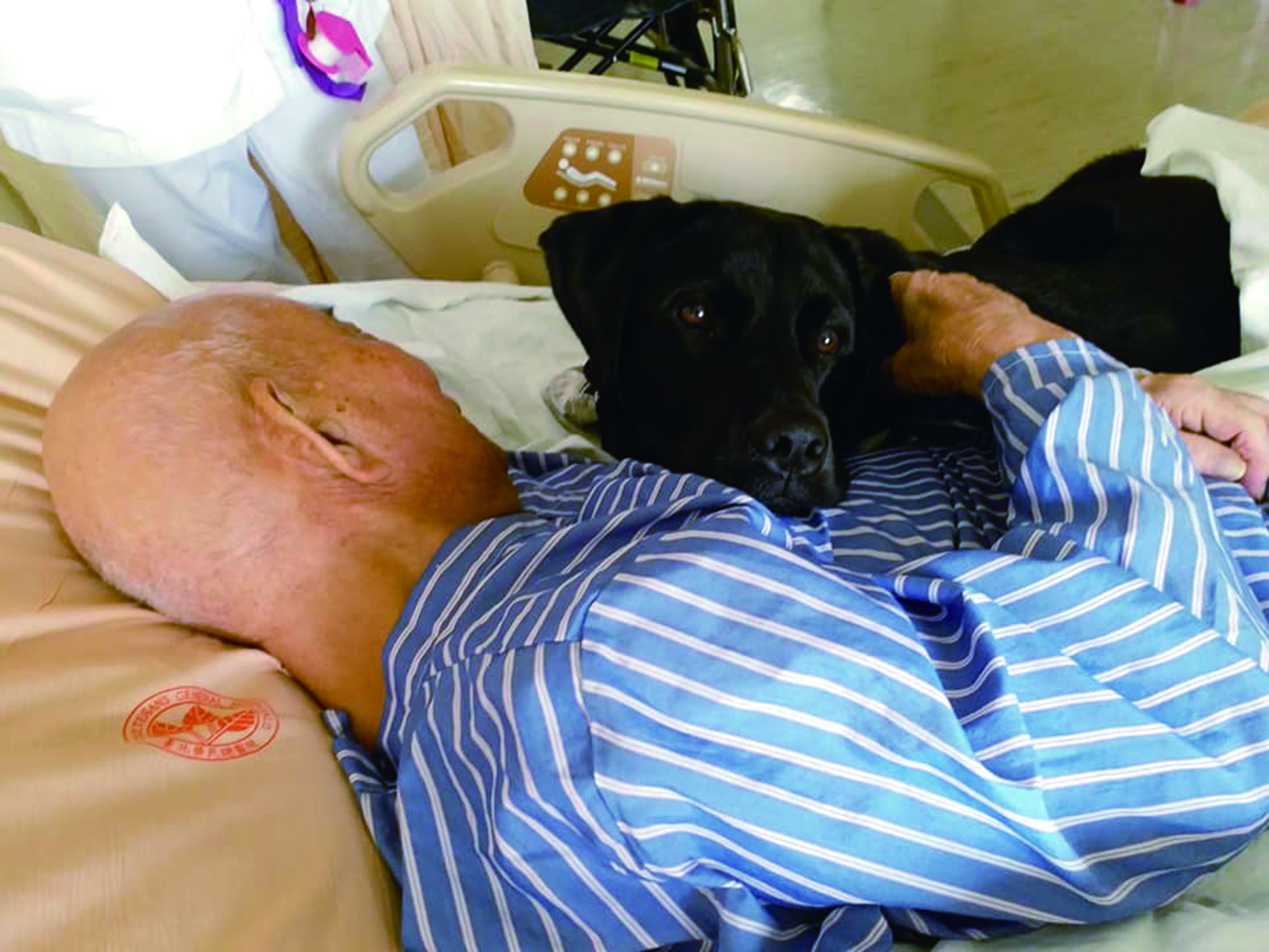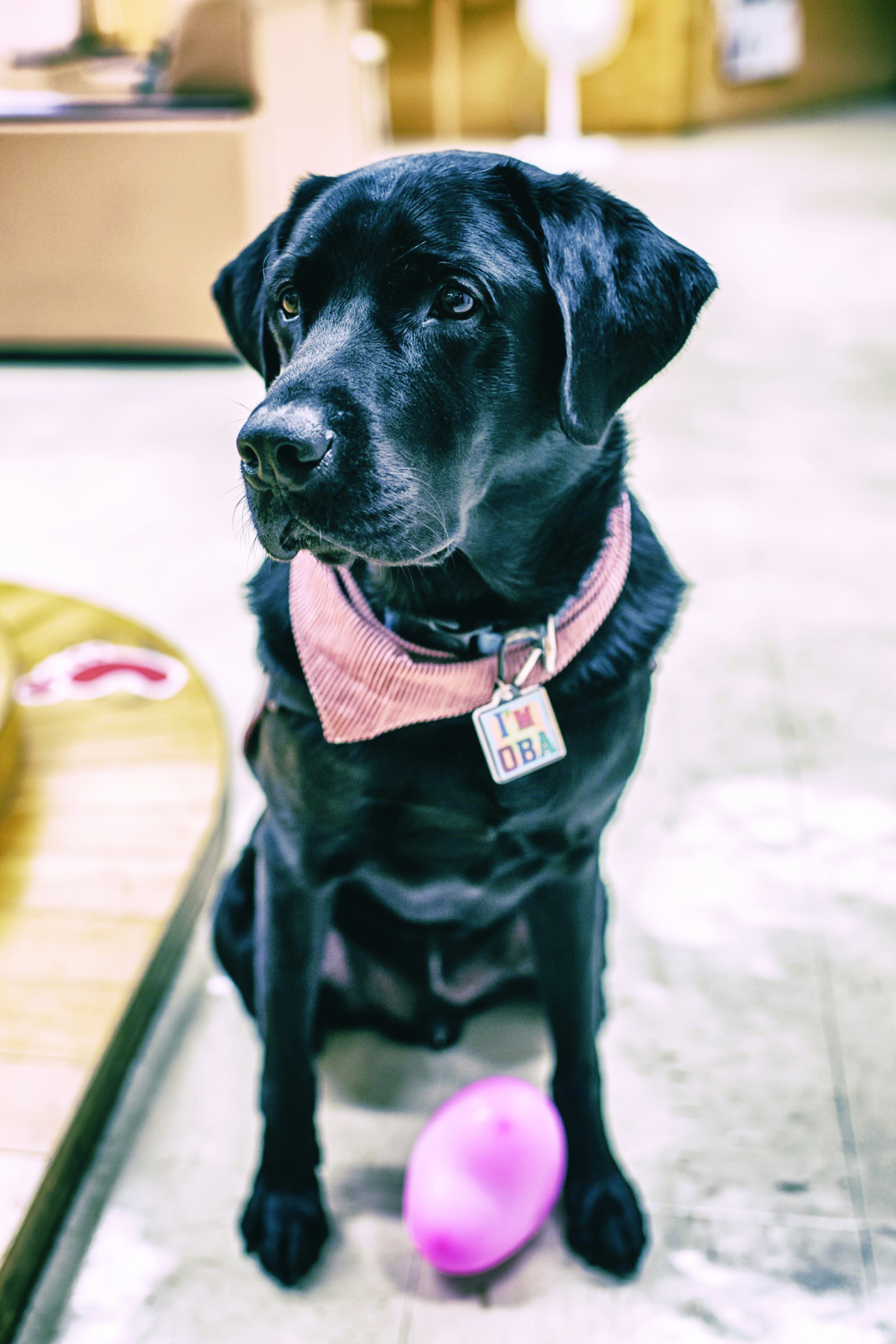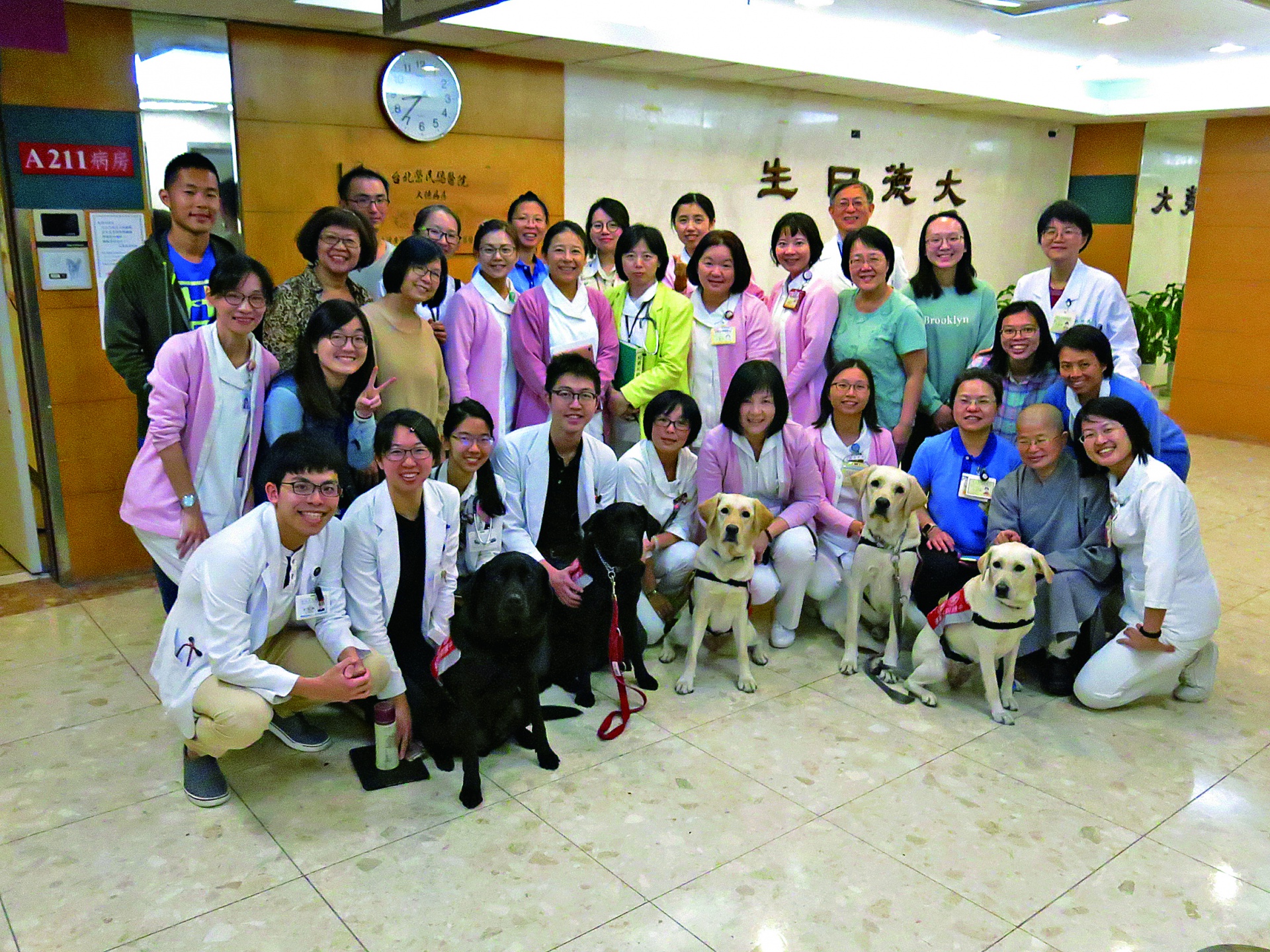"Oba, you are here!" rings throughout the hospital whenever Taipei Veterans General Hospital's adjuvant therapy dog, Oba, appears; the hearts of many patients and their families have been melted by these innocent puppy eyes. Animal therapy has been around for many years, and the children and the medical team have overcome various challenges to bring healing to the hearts of patients in the ward, old and young alike.

In the Dade Hospice Ward at the Taipei Veterans General Hospital (“TVGH”), when the doctor is making his rounds, he is often quietly followed by a small assistant behind him. When patients and families see this assistant, their facial expressions become relaxed, and smiles appear. The canine assistant certainly has a very important role in the TVGH Dade Hospice care team. It is TVGH's "Dog Doctor" named “Oba”.
Changing Career Paths: Guide Dog Transforms into Adjuvant Therapy Dog
With its stable personality, Oba looks calm even in unexpected situations. Originally, it was trained as a guide dog, but because it walked so slowly, it couldn't find any visually impaired person to work with.
Even though it did not end up serving as a guide dog in the hospital, nevertheless, Oba was very useful, changing its career path as it entered the TVGH Dade Hospice Ward as an adjuvant therapy dog. He soon became an angel in the ward and gathered many fans. However, few people knew that in the course of introducing Oba as adjuvant therapy dog, the entire medical team went through many challenges and trials.
Prior to the resident adjuvant treatment dog program, the Taiwan Guide Dog Association would bring 2 to 4 guide dogs to Dade's ward every 2 weeks for visiting services. Every time the dogs arrived, the atmosphere in the ward became lively and cheerful, but due to the large number of patients, the interaction time for each dog and patient was quite limited. Therefore, in early 2019, the Taiwan Guide Dog Association became the first in Taiwan to propose a resident service plan, hoping to keep dogs in the hospital for longer periods while accompanying patients in the hospice ward.
Despite the favorable recommendation of the Taiwan Guide Dog Association and support from the TVGH Dade Hospice Ward team, there were still many concerns. For example, the daily care of the dogs requires a lot of manpower and effort. Each medical staff already had a full schedule, and the implementation seemed difficult. In the midst of the dilemma, a joint effort by nursing caregiver Ms. Yang Wanling and nursing educator Ms. Liu Xiaojing, rose to take over this task, which began their relationship with Oba.
Self-Disciplined Life Style, Even Better than Human
Both caregivers said they had experiences in raising dogs when they were young, but it was still quite different taking care of professional working dogs. Since Oba’s living habits and social etiquette had already been trained very well, their main task would be regarding Oba’s daily routine, such as cleanliness, health, and maintaining its training performance. Just for these duties, the two caregivers spent three months learning in the Taiwan Guide Dog Association. During the training process, they fully realized how difficult it was to take care of a guide dog.
During the period, the team also thought about what Oba could do after it officially joined the ward, especially when the nature between a guide dog and an adjuvant therapy dog is different. No one is supposed to play with a guide dog, including not touching or calling it; however, the work of adjuvant therapy dogs is mainly to provide patients with various forms of companionship and comfort, which heavily entails interacting with people. Thus, the question arose of if and what key adjustments needed to be made in Oba's service model.
Fortunately, these concerns disappeared after Oba officially started its work. Oba, who is highly cooperative, did not refuse requests to play from the patients. Sometimes, the patients or their families simply could not help but reach for a warm hug and Oba graciously accepts. Upon such interactions with feeling Oba or even sleeping next to Oba, many patients have obtained great comfort for both body and mind.
In order to comply with various specifications of the medical institution, in addition to the regular teeth brushing, face washing, body cleaning and combing, Oba also has a health journal, which is a detailed health record including monthly flea removal and heartworm prevention, as well as annual vaccination and health examinations. It helps to achieve regularity in Oba’s daily eating, urinating, and various other activities such that the dog’s rituals are even better organized than some people!
In fact, the medical team took such good care of Oba that, according to Yang Wanling with a smile, “Oba has recently gained 0.5 kg. Fearing that Oba might be recalled by the Taiwan Guide Dog Association due to overweight issues, staff members have taken it swimming and exercising, and together, we are more strictly monitoring its diet."
Currently, Oba's daily work is to accompany the doctor to make rounds in the ward. Whenever new patients are admitted, it will also be introduced to the patients and their family. When patients apply for companionship with Oba, the medical team will first evaluate the patients’ condition and confirm the safety of the environment. In particular, patients with terminal cancer usually have many intubations on their bodies, which make them more fragile and easily injured. Therefore, special attention to safety must be made when patients wish to interact with Oba.
Heartwarming Interaction and Companionship Make Life Complete

According to Chen Xiaoni, the nursing director of Dade Hospice Ward, since Oba joined the team, not only have the patients and their families been helped, but also the medical team has benefited. She says, “The nursing staff's emotions inevitably fluctuate due to working in intensive life-and-death situations all the time, and so when they are feeling down, they find Oba to help relieve pressure and receive emotional healing for themselves. I often see staff members walking toward Oba with frustration on their faces, but as they walk away they have big smiles. I can only say that Oba's treatment works amazingly well for everyone!”
In less than a year, many touching stories of Oba and patients have been witnessed. One of the most impressive stories that Liu Xiaojing remembers is a 6-year-old child with terminal cancer in the pediatric ward. At that time, his mother desired that the child could see Oba, so after obtaining the consent of his attending physician, nurse, and other related personnel, Oba was brought to the ward.
On the day of Oba’s visit, children from other wards came around curiously, and played with Oba. With friendly shaking of her tail, Oba responded playfully to the children's enthusiasm. Because the 6-year-old child was vaguely conscious, Liu Xiaojing obeyed his mother's request and lifted Oba onto the hospital bed to accompany her son. At that moment, the boy’s hand slid into Oba's vest, and at first, the mother was afraid that the child would feel uncomfortable and she lifted his hand back; however, unexpectedly, the child slowly withdrew his hand from the mother, and returned to Oba's vest. He even started petting and rubbing Oba's hair.
Afterwards, the mother excitedly told Liu Xiaojing that her child had not had such an active and positive reaction for a long time. She also mentioned that the child loved dogs very much and recalled her promise to the child that he could have a dog when he was in the third grade. However, the child became ill with cancer, and many treatments and efforts failed. The mother knew that this wish could not come true, so she hoped that Oba could continue to accompany the child and fulfill his wish of having a dog. Just two weeks later, the child passed away. Nevertheless, even today, Liu Xiaojing remembers the warm and affectionate scene of that moment, and her eyes still reddens.
There was another terminal cancer patient who also loved dogs. At the later stage of cancer, half of his body was severely eroded by cancer cells. The severe pain often made it difficult for him to eat or sleep, but as soon as he saw Oba, his pain seemed to disappear and a long-lost smile reappeared in its place. His affection for Oba was so obvious that it even made his wife jealous because every time Oba visited, he would call Oba's name softly, pat the side of his bed, and have Oba sleep next to him. Oba made it possible for this patient to find restful sleep.
During that period with this patient, Oba would automatically report to the door of the ward every day, ready for duty. On the morning when he was about to pass away, the patient developed terminal restlessness, and his behavior, emotions, and physical reactions were difficult to control. However, when Oba appeared at his door on that day, the patient became surprisingly stabilized; when he fell asleep for the last time, Oba was right next to him.
As family members take care of their relatives in the hospice ward, they are burdened physically, mentally, and emotionally. To them, Oba is like a healing prescription, helping them ease and forget worries so that they can catch a breath and relax. After patients pass away, most family members are reluctant to return to a place of sadness; however, in Oba’s case, many people actually return to visit because they want to see Oba. These family members are very grateful to Oba for having created such beautiful end-of-life memories for them, and provided a strong, meaningful bond with their loved ones.
Changing Traditional Thinking by Creating a Friendly Environment for Adjuvant Therapy Dogs
Today, the hospital staff has become accustomed to Oba's presence. The canine friend is really popular and is often greeted with great fanfare around the hospital. Looking back to the beginning of the resident adjuvant therapy dog program, the medical team had initial doubts and objections, including fear that the dog’s barking would disturb patients' recuperation; defecating and cleaning problems would affect the sanitation of the medical environment; and walking and running would scare or disrupt patients and their families, and etc. In order to eliminate these doubts, in addition to the health journal and guide dog training regulations mentioned previously, the medical team also established a set of adjuvant therapy dog SOPs to ensure that these problems do not occur. Thus far, Oba's excellent performance has been the best proof of his success.
Chen Xiaoni said that interaction with animals can make people feel happy and bring about a positive, calming effect; thus, animal-assisted activities can be used in children's learning, last stage of life companionship, and physical and mental rehabilitation.
For example, one dementia patient who had chronic diseases used to constantly take off all his clothes at a pace faster than the nursing staff could put them back on, so the caregiver was always agitated when taking care of him. Then one day, the Taiwan Guide Dog Association came with several dogs to visit, and some people suggested to let that patient hold a dog's leash. Surprisingly, as he held the leash eagerly with both hands, he quickly calmed down and dozed off, no longer frantically ripping off his clothes. Later, when the staff wanted to take the leash away from his hands, he still held on tightly to it, refusing to let go.
"In fact, adjuvant therapy dogs have already been around for many years in other countries,” says Yang Wanglin. “For example, in Japan, hospitals not only have dog veterinarians permanently stationed, but also have dedicated one-on-one trainers to take care of these dogs. In some cases, the hospitals have even designed special isolation gowns allowing dog doctors to enter isolation wards for visiting purposes.”
Here in Taiwan, there are also Dog Veterinarian and Professional Animal-Assisted Therapy Associations that regularly visit nursing homes and special education centers to provide related services. Unfortunately, due to current regulations, only guide dogs can enter public venues. Coupled with insufficient publicity, adjuvant therapy dogs often encounter obstacles and skeptical looks when they enter medical institutions. It is hoped that in the near future, with more efforts in publicity and promotion, Taiwan can provide a friendlier service environment for adjuvant therapy dogs in order to benefit more patients.

